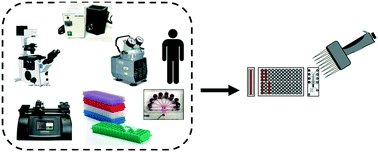Point of care whole blood microfluidics for detecting and managing thrombotic and bleeding risks
Abstract
Point-of-care diagnostics of platelet and coagulation function present demanding challenges. Current clinical diagnostics often use centrifuged plasmas or platelets and frozen plasma standards, recombinant protein standards, or even venoms. Almost all commercialized tests of blood do not recreate the in vivo hemodynamics where platelets accumulate to high densities and thrombin is generated from a procoagulant surface. Despite numerous drugs that target platelets, insufficient coagulation, or excess coagulation, POC blood testing is essentially limited to viscoelastic methods that provide a clotting time, clot strength, and clot lysis, while used mostly in trauma centers with specialized capabilities. Microfluidics now allows small volumes of whole blood (<1 mL) to be tested under venous or arterial shear rates with multi-color readouts to follow platelet function, thrombin generation, fibrin production, and clot stability. Injection molded chips containing pre-patterned fibrillar collagen and lipidated tissue factor can be stored dry for 6 months at 4C, thus allowing rapid blood testing on single-use disposable chips. Using only a small imaging microscope and micropump, these microfluidic devices can detect platelet inhibitors, direct oral anticoagulants (DOACs) and their reversal agents. POC microfluidics are ideal for neonatal surgical applications that involve small blood samples, rapid DOAC testing in stroke or bleeding or emergency surgery situations with patients presenting high risk cofactors for either bleeding or thrombosis.

- This article is part of the themed collection: Microfluidics for hematology


 Please wait while we load your content...
Please wait while we load your content...